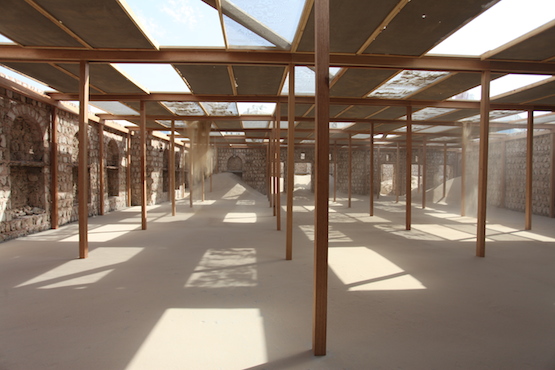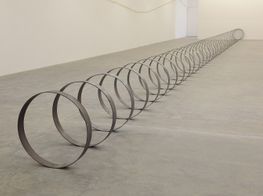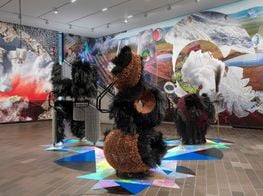Eungie Joo
HH Sheikh Dr. Sultan bin Mohammed Al Qasimi and SB12 curator Eungie Joo at the Opening of Sharjah Biennial 12 (2015). Photo by Alfredo Rubio. Courtesy Sharjah Art Foundation.
HH Sheikh Dr. Sultan bin Mohammed Al Qasimi and SB12 curator Eungie Joo at the Opening of Sharjah Biennial 12 (2015). Photo by Alfredo Rubio. Courtesy Sharjah Art Foundation.
Eungie Joo is the curator of Sharjah Biennial 12: The past, the present, the possible, presented from March to June 2015. The exhibition was staged in sites in and around Sharjah, including the city of Kalba on the Gulf of Oman.
More than 50 artists and cultural practitioners from over 25 countries took part, from Ruanne Abou-Rahme and Basel Abbas and Mark Bradford to Haegue Yang, with over two-thirds presenting new works and commissions. In this interview, Joo who is the former Director of Art and Cultural Programs at Instituto Inhotim in Brumadinho, Brazil, and previously served as the Keith Haring Director and Curator of Education and Public Programs at the New Museum of Contemporary Art in New York, discusses SB12's intentions.
These include building on a commitment by the Sharjah Art Foundation, who organises the Sharjah Biennial, to artistic production and development in the region, while reflecting on how the context of Sharjah might inform the practices of a diverse group of artists.
SBHow do you feel about Sharjah Biennial 12 now that it has opened?
EJI feel very pleased that the artists really rose to the occasion and I think everybody looks strong in what they do. Even if you don't particularly like what they do, everyone is presented on an equal level. The artists gave a lot of themselves to this exhibition, and you can see it in their work, which feels great. Really meaningful relationships developed out of this process, between the artists, with the whole team that worked on the exhibition and with the curators. This biennial is about ways of working, which to me is public engagement. As a microcosm, this is a measure of success.
SBThis engagement was very much facilitated through the creation of new commissions for the exhibition. Did this allow for conversations to develop and evolve during the production of the exhibition?
EJI have had the great fortune of working with many of the artists presented in this exhibition for 10 or more years, so I had an idea of how they are developing their work and their thinking. In this way, it becomes more about wanting to get people in a room together: for different artists to meet each other on the other side of the world. Imagining potential relationships meant thinking how a painter might benefit from meeting a time-based artist, for example. I think this kind of matchmaking—of ideas and ways of thinking—is also important when putting a group exhibition of this sort together. We were trying to take the time together as a group, which started with the March Meeting in 2014, and by doing group site visits throughout the preparation. There was never more than two weeks from March 2014 until the opening in March 2015 that there wasn't one or more participating artists in Sharjah, actually. This was an important thing to keep us moving forward throughout the year. And I think it was also an important experience for the Sharjah Art Foundation team to have the artists here, too, reminding them of the urgency in the way artists work, which is very contagious. So I think people got very involved. The members of the biennial team were so engaged in the process of producing the work. It was great to be a part of.
SBWould you describe some of the conversations in terms of how they manifested in the groupings of works within the curatorial theme and the choice of locations? There was Port Khalid, the Flying Saucer and the Kalba Ice Factory, for instance, which were used for the first time in the Sharjah Biennial's history...
EJSome of the locations were decided by the artists—they wanted to work in a certain building or courtyard—and some of it was necessitated by the scale of the work and a need for a space that could accommodate large works, but that was also intimate. The projects fit together perfectly: there's a kind of flow. But I also don't think this exhibition is so much about works as groupings but the exhibition as a whole. People keep asking me what's the theme or who best exemplifies the theme. But I keep trying to explain, there is no theme. There are moments that appear that are expected without being fully orchestrated in a rigid way. I didn't necessarily choreograph works to go with other works, but in the end there is this resonance between them that was beyond my intention. This is a conversation where you don't prescribe an exact position. When you don't define exactly what you are doing. It opens up a place where these unpredictable resonances can occur.
SBIt's really amazing how a majority of the works on show are new and site-specific commissions. This created a sense of real and meaningful interaction between artists, works, and sites.
EJI have been working with some of these people for a long time. This is not the first large commission I have facilitated by Haegue Yang, for example. In this case, we just had better research and more time. And way more support technically: more workers, more engineers and more coordinators. The Sharjah Art Foundation team was willing to work with artists every step of the way. There was a great ambition on the part of the artists, and a great sensitivity to the fact that we were doing something here in this place. But I don't like to use the word site-specific: there is some level of specificity in many of these works; somehow they play with the tone of the place, the pace, the light, everyday life, the geology, all of these things.
This experience formed the conversations between the artists. So many people met each other, re-met each other, and went over ideas or commented on things they saw. They shared knowledge.
SBThe result is the production of a kind of microcosm produced amongst the works in the exhibition. This relates to what you said about there being no real curatorial theme for this edition of the Sharjah Biennial beyond the idea of engendering collaboration and possibility.
EJThat's the frame. In most cases, I just invited artists to come to Sharjah and make a proposal. So the artists create the context: they are the context. They shape the way we think. Maybe this is my particular sensitivity because my brother is an artist who trained me to understand what risks there are when making work and what an artist's vulnerability is to present something new. Understanding that or having some beginning of an insight to that—you know what is really at stake for an artist producing something and showing it for the first time—knowing all of this, you have to let the artist lead.
SBThis makes me think of the March Meeting in 2014, and the theme it proposed through the event's title: 'Come Together.' The title was reflected in the theme of Sharjah Biennial 12, which intended to bring people together in order to see what might happen as a result of such gatherings.
EJExactly. You have to start with sharing knowledge. Part of how we get to the same page is to share information with each other and enlighten each other with our own insights and perspectives. It helps. I appreciate it. I learned a lot. I left the March Meeting thinking, 'Wow, I know a lot of smart people. Look at the passion and talent in this room.' I was really moved by that. It reaffirms my belief that artists can lead us in our thinking. I mean, I don't know if I would give them my bank book, but if I want to be challenged in my way of thinking... I would like an artist to show me ways of thinking within a larger conceptual framework of how we should work together, what are we doing this all for. What are the possibilities of experimentation or transcending the limitations that we meet in front of us in this disastrous world that we are currently living in? In this impasse I would like to hear from good people: people who have philosophical, intellectual, creative minds of integrity, of character. I want them to tell me how to think. I can provide a context that is supportive and of course, has some money to make things happen. The basic philosophy is: I do what I can, and you do what you do. This leaves me a bit in awe of everybody. Everybody did his or her job beautifully, and you can see it. —[O]

















































































































































































